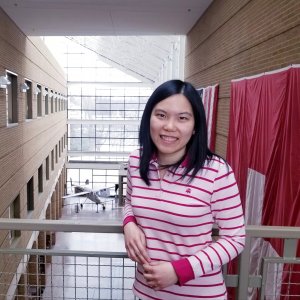Presented By: Aerospace Engineering
Dissertation Defense: Towards Automated, Metric-Conforming, Mesh Generation: An Optimization Framework for Adaptive, High-Order, Finite-Element Methods
Devina P. Sanjaya

Devina P. Sanjaya
Presentation Info:
Date: March 29, 2019
Time: 12:30 PM
Location: Johnson Room, Lurie Engineering Center
Dissertation Committee Names:
Chair: Assoc. Prof. Krzysztof J. Fidkowski
Cognate Member: Assoc. Prof. Eric Johnsen
Members:
Prof. Joaquim R. R. A. Martins
Dr. Scott M. Murman, NASA Ames Research Center
Dr. Marian Nemec, NASA Ames Research Center
Abstract:
Computational fluid dynamics (CFD) has joined the wind tunnel and flight test as a critical aircraft design tool. However, despite decades of development and its prevalent use in industry, CFD is still not yet mature. Indeed, the question on whether a mesh is sufficiently fine or is of good enough quality to achieve the desired accuracy and robustness remains difficult to answer to this day. The root of the problem is the reliance on user’s experience to determine the regions where mesh resolution is necessary, a task that is not trivial. This dissertation aims to tackle this problem.
Given a discretization method and an output (e.g., lift or drag), our algorithm places the element’s vertices and high-order nodes in a fully-automated manner. A Riemannian metric field is used to encode the element’s shape and size and to combine several adaptation methods. The mesh is generated in two stages: 1) generate a linear, metric-conforming mesh, and 2) solve an optimization problem to incorporate the high-order information. Unlike the current meshing practice, the high-order nodes can be clustered as long as the element remains valid. With only marginal increase in computational cost and no additional software complexities, the final mesh reduces error by at least a factor of two.
Presentation Info:
Date: March 29, 2019
Time: 12:30 PM
Location: Johnson Room, Lurie Engineering Center
Dissertation Committee Names:
Chair: Assoc. Prof. Krzysztof J. Fidkowski
Cognate Member: Assoc. Prof. Eric Johnsen
Members:
Prof. Joaquim R. R. A. Martins
Dr. Scott M. Murman, NASA Ames Research Center
Dr. Marian Nemec, NASA Ames Research Center
Abstract:
Computational fluid dynamics (CFD) has joined the wind tunnel and flight test as a critical aircraft design tool. However, despite decades of development and its prevalent use in industry, CFD is still not yet mature. Indeed, the question on whether a mesh is sufficiently fine or is of good enough quality to achieve the desired accuracy and robustness remains difficult to answer to this day. The root of the problem is the reliance on user’s experience to determine the regions where mesh resolution is necessary, a task that is not trivial. This dissertation aims to tackle this problem.
Given a discretization method and an output (e.g., lift or drag), our algorithm places the element’s vertices and high-order nodes in a fully-automated manner. A Riemannian metric field is used to encode the element’s shape and size and to combine several adaptation methods. The mesh is generated in two stages: 1) generate a linear, metric-conforming mesh, and 2) solve an optimization problem to incorporate the high-order information. Unlike the current meshing practice, the high-order nodes can be clustered as long as the element remains valid. With only marginal increase in computational cost and no additional software complexities, the final mesh reduces error by at least a factor of two.